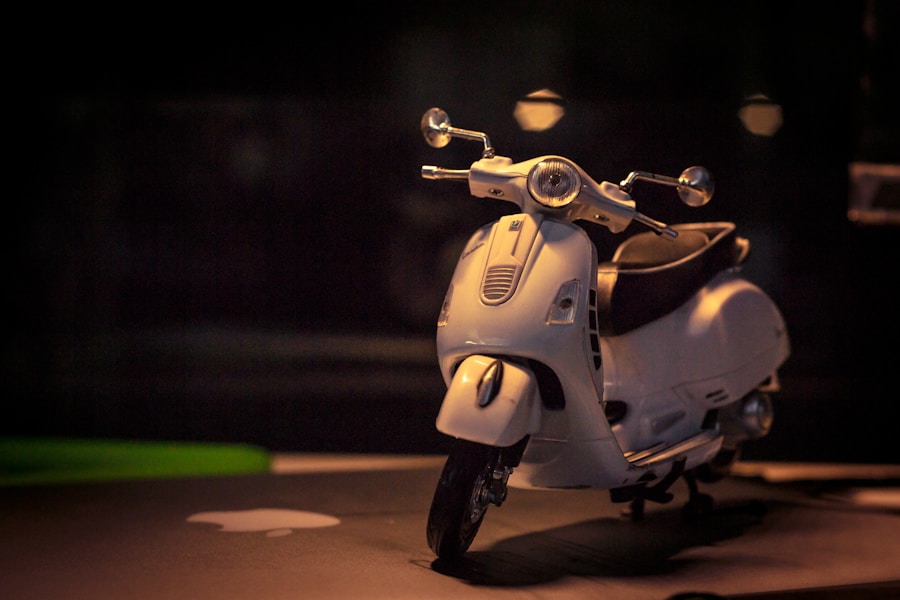Kwota: 3 098,45 €
Przyszłość motocykli elektrycznych: jazda w kierunku zrównoważonej przyszłości
Branża motocykli elektrycznych odnotowała w ciągu ostatniej dekady znaczny wzrost popularności, napędzany połączeniem postępu technologicznego, troski o środowisko naturalne oraz zmieniających się preferencji konsumentów. W miarę jak obszary miejskie stają się coraz bardziej zatłoczone, a poziom zanieczyszczeń rośnie, wielu motocyklistów poszukuje alternatyw dla tradycyjnych motocykli benzynowych. Motocykle elektryczne oferują atrakcyjne rozwiązanie, łącząc emocje z jazdy z korzyściami w postaci niższej emisji spalin i niższych kosztów eksploatacji.
Ta zmiana to nie tylko trend; to fundamentalna zmiana w naszym postrzeganiu transportu osobistego. Do wzrostu popularności motocykli elektrycznych przyczyniło się kilka czynników. Rosnąca świadomość zmian klimatycznych i pilna potrzeba zmniejszenia śladu węglowego skłoniły konsumentów do poszukiwania bardziej ekologicznych alternatyw.
Co więcej, postęp w technologii akumulatorów znacząco poprawił osiągi i zasięg motocykli elektrycznych, czyniąc je bardziej użytecznymi w codziennym użytkowaniu. Producenci oferują obecnie modele, które mogą konkurować z ich benzynowymi odpowiednikami pod względem prędkości, zasięgu i ogólnych wrażeń z jazdy. W rezultacie motocykle elektryczne nie są już postrzegane jako produkty niszowe, lecz jako popularna opcja zarówno do dojazdów do pracy, jak i jazdy rekreacyjnej.
Najważniejsze wnioski
- Motocykle elektryczne cieszą się coraz większą popularnością ze względu na korzyści dla środowiska i postęp technologiczny.
- Zalety motocykli elektrycznych obejmują niższe koszty eksploatacji, zmniejszoną emisję spalin i cichszą pracę.
- Do wyzwań i ograniczeń związanych z motocyklami elektrycznymi należą ograniczony zasięg, dłuższy czas ładowania i konieczność rozwoju infrastruktury.
- Innowacje w technologii motocykli elektrycznych skupiają się na poprawie wydajności akumulatorów, zwiększeniu zasięgu i udoskonaleniu infrastruktury ładowania.
- Motocykle elektryczne mają pozytywny wpływ na środowisko, ponieważ redukują zanieczyszczenie powietrza i hałas oraz zmniejszają zależność od paliw kopalnych.
Zalety motocykli elektrycznych
Jedną z najważniejszych zalet motocykli elektrycznych jest ich wpływ na środowisko. W przeciwieństwie do tradycyjnych motocykli, które emitują szkodliwe zanieczyszczenia, modele elektryczne nie emitują spalin. Ta cecha jest szczególnie korzystna w miastach, gdzie jakość powietrza stanowi coraz większy problem.
Wybierając pojazdy elektryczne, motocykliści przyczyniają się do czystszego powietrza i zdrowszej planety. Co więcej, wraz ze wzrostem wykorzystania odnawialnych źródeł energii, takich jak wiatr i słońce, w sieciach elektroenergetycznych, całkowity ślad węglowy związany z ładowaniem motocykli elektrycznych stale się zmniejsza. Oprócz korzyści środowiskowych, motocykle elektryczne oferują również znaczące korzyści ekonomiczne.
Koszt energii elektrycznej jest zazwyczaj niższy niż benzyny, co z czasem przekłada się na znaczne oszczędności w wydatkach na paliwo. Niższe są również koszty utrzymania, ponieważ motocykle elektryczne mają mniej części ruchomych w porównaniu z ich odpowiednikami z silnikiem spalinowym. Nie ma potrzeby wymiany oleju, rzadziej wymienia się hamulce dzięki układom hamowania rekuperacyjnego, a zużycie podzespołów jest mniejsze.
Połączenie niższych kosztów eksploatacji i mniejszych potrzeb konserwacyjnych sprawia, że motocykle elektryczne są atrakcyjną opcją dla oszczędnych konsumentów.
Wyzwania i ograniczenia

Pomimo licznych zalet, motocykle elektryczne borykają się z wieloma wyzwaniami, które mogą utrudniać ich powszechne zastosowanie. Jednym z głównych problemów jest obawa o zasięg – strach przed wyczerpaniem się akumulatora przed dotarciem do celu. Chociaż postęp w technologii akumulatorów znacznie poprawił zasięg, wiele motocykli elektrycznych nadal nie dorównuje zasięgowi tradycyjnych motocykli.
To ograniczenie może być szczególnie problematyczne dla osób pokonujących duże odległości lub mieszkających na obszarach o ograniczonej infrastrukturze ładowania. Kolejnym wyzwaniem jest początkowa cena zakupu motocykli elektrycznych, która może być wyższa niż w przypadku modeli konwencjonalnych. Chociaż ceny spadają wraz z postępem technologicznym i zwiększeniem skali produkcji, początkowy koszt pozostaje barierą dla wielu potencjalnych nabywców.
Ponadto dostępność stacji ładowania może się znacznie różnić w zależności od regionu, co utrudnia niektórym kierowcom znalezienie dogodnych miejsc do ładowania pojazdów. Ten brak infrastruktury może zniechęcać potencjalnych nabywców, którzy obawiają się o praktyczność posiadania motocykla elektrycznego.
Innowacje w technologii motocykli elektrycznych
| Innowacje technologiczne w motocyklach elektrycznych | Rok | Uderzenie |
|---|---|---|
| Ulepszona technologia baterii | 2020 | Większy zasięg i szybsze ładowanie |
| Systemy hamowania regeneracyjnego | 2018 | Poprawiona efektywność energetyczna |
| Zaawansowane sterowniki silników | 2019 | Lepsza wydajność i kontrola |
| Materiały lekkie i o wysokiej wytrzymałości | 2021 | Poprawiona zwinność i wytrzymałość |
Sektor motocykli elektrycznych przeżywa dynamiczny rozwój, a producenci nieustannie opracowują nowe technologie, aby poprawić osiągi i komfort użytkowania. Jednym z istotnych postępów jest rozwój akumulatorów litowo-jonowych o dużej pojemności, które oferują większy zasięg i krótszy czas ładowania. Akumulatory te stają się coraz lżejsze i wydajniejsze, co pozwala producentom projektować smuklejsze i mocniejsze motocykle elektryczne bez kompromisów w zakresie masy i prowadzenia.
Kolejną ekscytującą innowacją jest integracja inteligentnej technologii z motocyklami elektrycznymi. Wiele nowoczesnych modeli jest obecnie wyposażonych w takie funkcje, jak łączność ze smartfonem, nawigacja GPS oraz zaawansowane systemy bezpieczeństwa, takie jak układ ABS i kontrola trakcji. Technologie te nie tylko poprawiają komfort jazdy, ale także bezpieczeństwo motocyklistów.
Co więcej, niektórzy producenci badają możliwość wykorzystania sztucznej inteligencji w celu optymalizacji systemów zarządzania akumulatorem, co pozwoli użytkownikom w pełni wykorzystać potencjał ich motocykli elektrycznych, minimalizując jednocześnie zużycie energii.
Wpływ na środowisko
Wpływ motocykli elektrycznych na środowisko wykracza poza samo ograniczanie zanieczyszczenia powietrza w obszarach miejskich. Produkcja i utylizacja akumulatorów używanych w pojazdach elektrycznych rodzi istotne pytania dotyczące zrównoważonego rozwoju i zarządzania zasobami. Chociaż motocykle elektryczne nie emitują żadnych emisji podczas eksploatacji, wydobycie surowców do produkcji akumulatorów – takich jak lit, kobalt i nikiel – może mieć poważne konsekwencje dla środowiska, jeśli nie jest zarządzane w sposób odpowiedzialny.
Firmy coraz częściej koncentrują się na zrównoważonych praktykach pozyskiwania surowców i programach recyklingu, aby łagodzić te skutki. Co więcej, wraz ze wzrostem liczby użytkowników motocykli elektrycznych, istnieje potencjał do szerszej zmiany nawyków transportowych, co może prowadzić do zmniejszenia korków i niższego ogólnego zużycia energii. Motocykle elektryczne mogą pomóc odciążyć systemy transportu publicznego, stanowiąc wydajną alternatywę dla krótkich dojazdów.
Zmiana ta może przyczynić się do powstania bardziej zrównoważonego środowiska miejskiego, w którym mobilność osobista będzie realizowana przy minimalnym wpływie na środowisko.
Przyszłość infrastruktury motocykli elektrycznych

Przyszłość infrastruktury dla motocykli elektrycznych ma kluczowe znaczenie dla wsparcia rozwoju tego dynamicznie rozwijającego się rynku. Wraz ze wzrostem popytu na pojazdy elektryczne rośnie również zapotrzebowanie na rozbudowaną sieć stacji ładowania, dostosowanych do potrzeb użytkowników motocykli. W przeciwieństwie do samochodów, które często można ładować w domu lub na dedykowanych stacjach ładowania, motocykle elektryczne wymagają bardziej dostępnych rozwiązań ładowania ze względu na mniejsze akumulatory i inne sposoby użytkowania.
Miasta na całym świecie zaczynają dostrzegać tę potrzebę i podejmują kroki w celu zintegrowania infrastruktury ładowania z inicjatywami urbanistycznymi. Obejmuje to instalację stacji ładowania w miejscach publicznych, takich jak parkingi, centra handlowe i wzdłuż popularnych tras dojazdowych. Ponadto, niektóre gminy poszukują innowacyjnych rozwiązań, takich jak stacje ładowania zasilane energią słoneczną, które mogą dostarczać energię bez konieczności korzystania z tradycyjnych sieci energetycznych.
W miarę rozwoju infrastruktury coraz bardziej prawdopodobne stanie się, że motocykle elektryczne staną się podstawowym środkiem transportu.
Rola polityki i zachęt rządowych
Polityka rządowa odgrywa kluczową rolę w kształtowaniu przyszłości motocykli elektrycznych, oferując zachęty, które zachęcają do ich zakupu zarówno konsumentów, jak i producentów. Wiele krajów wprowadziło ulgi podatkowe, rabaty lub dotacje dla osób kupujących pojazdy elektryczne, w tym motocykle. Te zachęty finansowe mogą znacząco obniżyć początkową barierę kosztową związaną z zakupem modelu elektrycznego.
Oprócz zachęt finansowych, rządy inwestują również w inicjatywy badawczo-rozwojowe mające na celu rozwój technologii pojazdów elektrycznych. Finansowając projekty skoncentrowane na innowacjach w zakresie akumulatorów lub rozwoju infrastruktury ładowania, decydenci mogą przyspieszyć transformację w kierunku zrównoważonych rozwiązań transportowych. Co więcej, przepisy mające na celu redukcję emisji z tradycyjnych pojazdów mogą stworzyć bardziej sprzyjające warunki dla motocykli elektrycznych, zachęcając konsumentów do wyboru bardziej ekologicznych alternatyw.
Rozwijający się rynek motocykli elektrycznych
Rynek motocykli elektrycznych dynamicznie się rozwija, ponieważ zainteresowanie konsumentów stale rośnie, a postęp technologiczny i polityka wspierająca ten rynek stale się rozwijają. Duzi producenci wkraczają na ten rynek z nowymi modelami, które zaspokajają potrzeby różnych segmentów – od skuterów dojeżdżających do pracy po wyczynowe motocykle sportowe – pokazując, że niemal każdy typ motocyklisty znajdzie coś dla siebie. Ta dywersyfikacja jest kluczowa dla przyciągnięcia szerszej publiczności i obalenia błędnych przekonań o ograniczonych osiągach i stylu pojazdów elektrycznych.
Wraz ze wzrostem świadomości i poprawą infrastruktury, prawdopodobnie w nadchodzących latach zaobserwujemy znaczny wzrost sprzedaży motocykli elektrycznych. Badania rynku wskazują, że młodsze pokolenia są szczególnie otwarte na pojazdy elektryczne ze względu na swoją świadomość ekologiczną i pragnienie innowacyjnych technologii. Ta zmiana demograficzna może dodatkowo zwiększyć popyt, ponieważ producenci zareagują, oferując produkty dostosowane do preferencji konsumentów dbających o środowisko, którzy cenią zrównoważony rozwój, nie rezygnując jednocześnie z osiągów i stylu.
Często zadawane pytania
Czym są motocykle elektryczne?
Motocykle elektryczne, znane również jako motocykle elektryczne, to pojazdy napędzane silnikami elektrycznymi i akumulatorami. Zostały zaprojektowane, aby stanowić bardziej przyjazną dla środowiska i energooszczędną alternatywę dla tradycyjnych motocykli napędzanych benzyną.
Jak działają motocykle elektryczne?
Motocykle elektryczne wykorzystują akumulatory do zasilania silnika elektrycznego, który z kolei napędza koła motocykla. Akumulatory można ładować, podłączając motocykl do gniazdka elektrycznego lub, w niektórych przypadkach, wymieniając je na w pełni naładowane.
Jakie są zalety motocykli elektrycznych?
Do zalet motocykli elektrycznych należą niższe koszty eksploatacji, mniejszy wpływ na środowisko, cichsza praca i potencjalnie niższe wymagania konserwacyjne w porównaniu z tradycyjnymi motocyklami benzynowymi. Oferują one również możliwość szybkiego przyspieszania i płynnej, cichej jazdy.
Jaka jest przyszłość motocykli elektrycznych?
Przyszłość motocykli elektrycznych rysuje się obiecująco, dzięki postępowi w technologii akumulatorów, infrastrukturze ładowania oraz ogólnej konstrukcji i wydajności. Wraz ze wzrostem zapotrzebowania na zrównoważone środki transportu, motocykle elektryczne prawdopodobnie zyskają na popularności i będą coraz powszechniej stosowane.
Jakie wyzwania stoją przed motocyklami elektrycznymi?
Wyzwania stojące przed motocyklami elektrycznymi obejmują ograniczony zasięg w porównaniu z motocyklami benzynowymi, dłuższy czas ładowania oraz konieczność dalszego rozwoju infrastruktury ładowania. Ponadto początkowy koszt motocykli elektrycznych może być wyższy niż w przypadku motocykli tradycyjnych, choć z czasem może to zostać zrekompensowane niższymi kosztami eksploatacji.

 OUKITEL Abearl P5000 przenośna elektrownia 5120 Wh LiFePO4 5 gniazd AC 2200 W Szybkie ładowanie AC 1800 W 15 wyjść z kółkami
OUKITEL Abearl P5000 przenośna elektrownia 5120 Wh LiFePO4 5 gniazd AC 2200 W Szybkie ładowanie AC 1800 W 15 wyjść z kółkami 